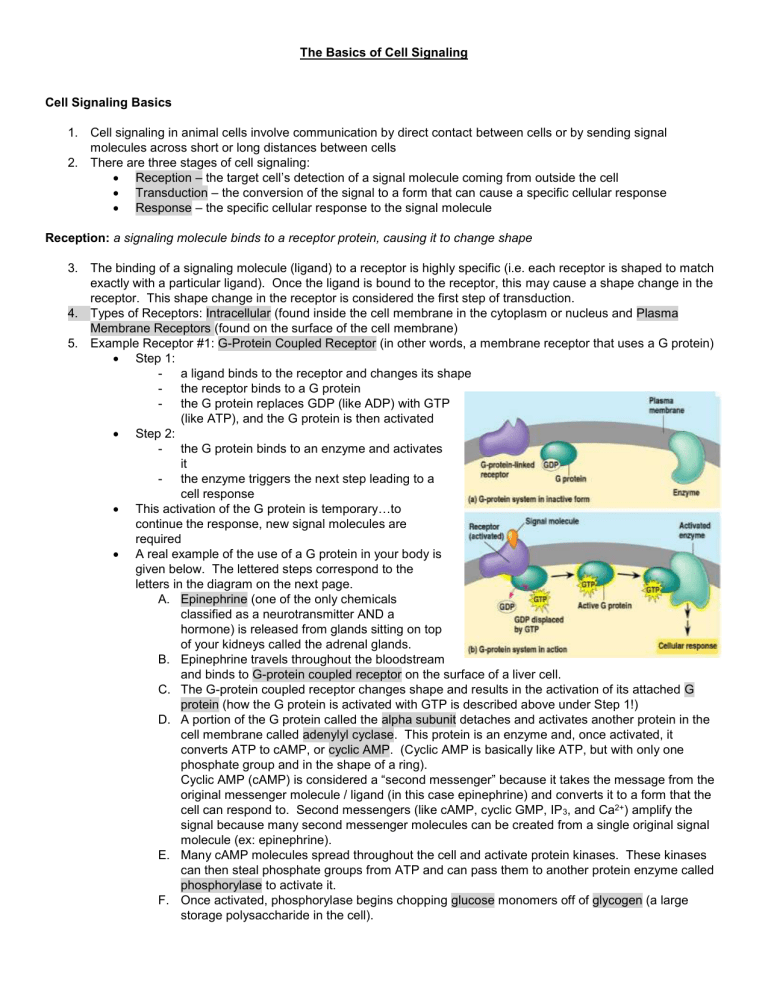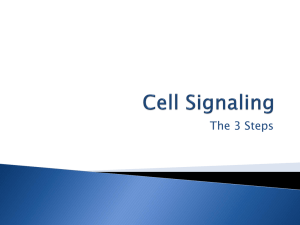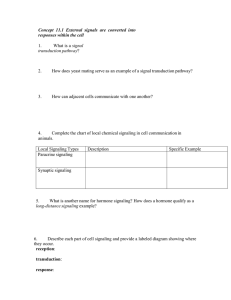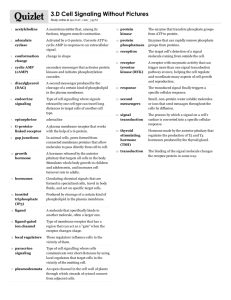Cell Signaling Basics: Receptors, Transduction, & Response
advertisement

The Basics of Cell Signaling Cell Signaling Basics 1. Cell signaling in animal cells involve communication by direct contact between cells or by sending signal molecules across short or long distances between cells 2. There are three stages of cell signaling: Reception – the target cell’s detection of a signal molecule coming from outside the cell Transduction – the conversion of the signal to a form that can cause a specific cellular response Response – the specific cellular response to the signal molecule Reception: a signaling molecule binds to a receptor protein, causing it to change shape 3. The binding of a signaling molecule (ligand) to a receptor is highly specific (i.e. each receptor is shaped to match exactly with a particular ligand). Once the ligand is bound to the receptor, this may cause a shape change in the receptor. This shape change in the receptor is considered the first step of transduction. 4. Types of Receptors: Intracellular (found inside the cell membrane in the cytoplasm or nucleus and Plasma Membrane Receptors (found on the surface of the cell membrane) 5. Example Receptor #1: G-Protein Coupled Receptor (in other words, a membrane receptor that uses a G protein) Step 1: - a ligand binds to the receptor and changes its shape - the receptor binds to a G protein - the G protein replaces GDP (like ADP) with GTP (like ATP), and the G protein is then activated Step 2: - the G protein binds to an enzyme and activates it - the enzyme triggers the next step leading to a cell response This activation of the G protein is temporary…to continue the response, new signal molecules are required A real example of the use of a G protein in your body is given below. The lettered steps correspond to the letters in the diagram on the next page. A. Epinephrine (one of the only chemicals classified as a neurotransmitter AND a hormone) is released from glands sitting on top of your kidneys called the adrenal glands. B. Epinephrine travels throughout the bloodstream and binds to G-protein coupled receptor on the surface of a liver cell. C. The G-protein coupled receptor changes shape and results in the activation of its attached G protein (how the G protein is activated with GTP is described above under Step 1!) D. A portion of the G protein called the alpha subunit detaches and activates another protein in the cell membrane called adenylyl cyclase. This protein is an enzyme and, once activated, it converts ATP to cAMP, or cyclic AMP. (Cyclic AMP is basically like ATP, but with only one phosphate group and in the shape of a ring). Cyclic AMP (cAMP) is considered a “second messenger” because it takes the message from the original messenger molecule / ligand (in this case epinephrine) and converts it to a form that the cell can respond to. Second messengers (like cAMP, cyclic GMP, IP3, and Ca2+) amplify the signal because many second messenger molecules can be created from a single original signal molecule (ex: epinephrine). E. Many cAMP molecules spread throughout the cell and activate protein kinases. These kinases can then steal phosphate groups from ATP and can pass them to another protein enzyme called phosphorylase to activate it. F. Once activated, phosphorylase begins chopping glucose monomers off of glycogen (a large storage polysaccharide in the cell). G. The glucose monomers are released from the liver cell into the bloodstream. These glucose monomers can be used as fuel/energy for your muscle cells, which must be used in the “fight or flight response” that results from epinephrine secretion, which occurs when you are afraid. 6. Example Receptor #2: Receptor Tyrosine Kinase (Note: Both types of receptors I am describing—G-protein coupled receptors and receptor tyrosine kinases—are examples of plasma membrane receptors, not intracellular receptors.) Step 1: - two signal molecules bind to two receptors, which come together to form a “dimer receptor” (di = two) - the dimer formation allows tyrosine kinases to “steal” phosphate groups from ATP, and the tyrosine kinases are now activated Step 2: - each phosphorylated receptor tyrosine kinase can begin a cellular response by activating “relay” (messenger) proteins by donating the active phosphate group to them 7. Typically, large, polar, or charged signal molecules bind to plasma membrane receptors because they cannot pass through the cell membrane to get to intracellular receptors. For example, epinephrine is an amine hormone, which is derived from the amino acid tyrosine. It is polar, so it is unable to pass through the non-polar tail region of the cell membrane. 8. Typically, small, non-polar signal molecules bind to intracellular receptors (i.e. receptors found inside the cell) because they can pass through the cell membrane (specifically the non-polar tail region) on their own. For example, steroid hormones like testosterone are non-polar. Transduction: chain reactions between many molecules result in the sending of a signal from the receptors to target molecules in the cell 9. Signal transduction pathways often involve a phosphorylation cascade where protein kinases phosphorylate MANY proteins at the next step to activate them the signal gets amplified! 10. The above example of the use of cAMP as a second messenger for the epinephrine ligand represents signal transduction as well. The signal from epinephrine is converted or “transduced” into a different form (MANY cyclic AMP molecules) and the signal is amplified! 11. Signals can be turned off by protein phosphatases that remove phosphate groups from proteins in the cascade Response: cell signaling leads take place in the nucleus or the cytoplasm to regulation of activities that 12. Nuclear Response: regulation of the creation of proteins from the DNA code (turning on specific genes used make certain proteins or turning them off). This is accomplished using molecules called transcription factors that can bind to and activate genes. 13. When a signal molecule binds to an intracellular receptor, the intracellular receptor becomes an active transcription factor and is able to bind to DNA and “turn on” particular genes. Thus, intracellular receptors are often associated with a direct nuclear response. Signal molecules that bind to plasma membrane receptors can also produce a nuclear response, but not directly. The signal molecules cannot pass through the plasma membrane, so they must elicit a nuclear response indirectly using second messengers and phosphorylation cascades to activate transcription factors. 14. Cytoplasmic Response: regulation of the activity of an enzyme that “hangs out” in the cytoplasm. Signal molecules that bind to plasma membrane receptors can produce a cytoplasmic response indirectly using second messengers and phosphorylation cascades to activate these cytoplasmic enzymes. The epinephrine pathway described earlier is an example of a cytoplasmic response caused by the binding of a signal molecule (i.e. epinephrine) to a plasma membrane receptor (i.e. a G-protein coupled receptor). The cytoplasmic enzyme used in this pathway is phosphorylase. The Types of Cell-Cell Communication Based on Distance between Cells 15. Cells can communicate by direct contact, over short distances, or over long distances. 16. Examples of communication by direct contact: Plant cells are connected to one another by plasmodesmata, holes in the cell walls of adjacent cell walls that allow materials to pass from the cytoplasm of one cell to the cytoplasm of another In the human immune system, the following process takes place to respond to and destroy pathogens (i.e. a disease-causing agent like a virus or bacterium). The lettered steps on the next page correspond to the letters in the diagram. A. A type of white blood cell called a macrophage (literally “big eater”) swallows any foreign particles (ex: viruses or bacteria). These foreign particles are also known as antigens. B. These antigens are “chopped up” by the macrophages. C. Pieces of the antigen are presented on the surface of the cell. For that reason, these macrophages are known as antigen-presenting cells. D. The presented antigens make direct contact with other white blood cells called helper T cells. E. The helper T cells then respond by causing the creation of antibodies that bind to that specific antigen when it is free-floating in the blood and the creation of killer T cells that bind to normal body cells that have been infected by that specific antigen and destroy them. 17. Examples of communication over short distances: ***Note: signal molecules that work across short distances are called local regulators*** When nerve cells (aka) neurons interact with each other, they send signal molecules called neurotransmitters across short distances… for example, a pain sensation neuron in your fingertip may send a signal to a neuron in your spinal cord. The neuron in your spinal cord then sends a signal to a motor (movement) neuron in your hand, causing you to pull your finger away from whatever has caused the pain stimulus. When one neuron sends a signal to another neuron, however, they are not physically connected. Instead, a molecule called a neurotransmitter is released from the axon tips of one neuron and travels across the space between the neurons called the synaptic cleft or simply, synapse. Once the neurotransmitter has diffused across the synapse, it binds to receptor proteins on the dendrites of the other neuron and causes the signal to be transmitted along the length of this new neuron. The images below show a zoomed out view (left) of the connections between two neurons, and a zoomed in view (right) of the connection between one axon tip (aka axon terminal) on a neuron and the dendrite membrane on another neuron. The number 1 in these images corresponds to the synapse between two neurons. The number 2 in these images corresponds to the axon tip(s). The number 3 in these images corresponds to the dendrite(s) of the second neuron. 18. Examples of communication over long distances: Hormones are chemicals that are secreted into the bloodstream by a tissue called a gland. These chemicals have multiple “target organs” in which they trigger a response. For example, human growth hormone is secreted by the pituitary gland in the brain when a person is going through puberty. This hormone travels through the blood stream and causes muscle, bone, and internal organ growth. A man named Robert Wadlow had a tumor pushing on his pituitary gland, causing it to overproduce growth hormone. As a result, he grew VERY tall and his condition was labeled “pituitary giantism.” 19. Communication by direct contact and over short distances tend to be very quick processes that produce a quick response. Despite this benefit, however, there can typically only be one target cell for each signal. 20. Communication over long distances allows signals (ex: hormones) that can be secreted into the bloodstream to cause a response in multiple target cells. Despite this benefit, however, communication over long distances is typically slower than communication by direct contact or over short distances. Comparing Cell Communication in Unicellular vs. Multicellular Organisms 21. Vibrio fischerii bacteria are single-celled organisms that communicate with one another to all glow (aka bioluminesce) at the same time. 22. These bacteria are found living in a species of squid called the Bobtail Squid. They are given food by the squid in exchange for glowing. The glowing allows the squid to camouflage with the sky above them and more easily catch prey. 23. In single-celled organisms, cell communication (ex: coordinating glowing) often occurs in response to some environmental stimulus. 24. When one Vibrio fischerii bacterium is living by itself (i.e. in planktonic form) it does not glow. 25. When Vibrio fischerii bacteria live together in a group (i.e. in colonial form), they glow. This is why they glow when they are super-concentrated in the eye pouch of the Bobtail Squid. 26. These bacteria give off protein signals into the surrounding environment all the time. These proteins are called autoinducers. If there are other bacteria of the same species in the area, they will come into contact with these autoinducer proteins. Reception of autoinducers in significant concentrations from other bacteria causes a signal transduction pathway that results in creation of a protein from the code in the bacteria cell’s DNA. This protein is called luciferase. Because its name ends in “-ase,” we know it is an enzyme. Luciferase breaks down a molecule called luciferan, causing the bacterium to glow. Broken-down Luciferan diffuses out of the bacterium and into nearby bacteria and causes them to glow as well. Bacteria use this method to save their energy until they have a high population density and can therefore produce a really nice glow. I’m not sure why the glow is evolutionarily adaptive for the bacteria except when they are living in symbiosis with the Bobtail squid and the glowing is their contribution to the symbiotic relationship. I’ve check several sources, but let me know if you figure it out!!! 27. When bacteria can detect other bacteria as their population density increases and respond in a particular way, this is called quorum sensing. 28. In multicellular organisms, communication between cells is used to coordinate the activities of the whole organism. An example of this is the release of epinephrine from cells in the human adrenal gland, which causes the liver to release glucose into the bloodstream. This glucose can be used to make ATP to power muscle cells, which allow the organism to respond by “fight or flight.” The Effects of Changes in Signaling Pathways 29. Anthrax (Bacillus anthracis) is a bacterial species that forms dormant spores when outside a host. If it is inhaled by a human, it will start to grow and feed in the lung tissue and produce a toxin. This toxin changes the shape of adenylyl cyclase so that it can no longer convert ATP to cyclic AMP. This disrupts a number of cell signaling pathways essential to normal body function because it interferes with a signal transduction pathway (using the second messenger cAMP) that used is to trigger many different responses in many different types of cells in the human body. 30. Diabetes mellitus is a disease that involves a disruption in a cell signaling pathway. The normal pathway is described in lettered steps on the next page, which are also found in the diagram. A. Normally, insulin (a hormone) is secreted from cells in the pancreas in response to high blood glucose levels. B. There are insulin receptors on the surface of liver cells that bind to insulin. C. A series of signal transduction steps occur after the binding of the insulin to the plasma membrane receptor protein. D. These signal transduction steps ultimately cause a glucose transport protein called (GLUT) to open and allow the entrance of glucose from the bloodstream into the liver cells. Once in the liver cells, glucose can be joined in chains to make glycogen (a storage polysaccharide). This lowers the amount of sugar in the blood to keep it within a safe range. People with Type I diabetes do not produce insulin, so their blood glucose levels are constantly too high unless they receive insulin shots or have an insulin pump that is directly linked to their bloodstream. People with Type II diabetes produce insulin but the insulin receptor does not respond to the insulin in the bloodstream. Overall, the effect is the same as with Type I diabetes. Glucose cannot leave the bloodstream and enter the liver cells. Notes Questions 1. Compare / contrast intracellular vs. plasma membrane receptors. Where is each receptor located, and what type of signal molecule binds to each receptor? 2. What is the main benefit of cell signaling via direct physical contact and cell signaling over short distances (ex: nerve cell signaling)? 3. What is the main benefit of cell signaling over long distances (ex: signaling via hormone secretion into the bloodstream)? 4. What is the benefit of using second messengers and phosphorylation cascades during the transduction step of cell signaling? 5. How is the purpose of cell signaling different in unicellular organisms vs. multicellular organisms? Provide an example of each. 6. Describe how epinephrine is used as a signaling molecule to cause the release of glucose from liver cells into the bloodstream. (Summarize and reword the steps given in the notes.)





